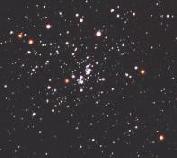
 STARS
STARS


ARRANGED BY SPECTRAL AND VARIABLE STAR CLASS
PROPER NAME VERSION
The stars of the main page are arranged vertically by their
colors (from blue to red) and temperatures (from about 50,000
Kelvin to under 3000 Kelvin) according to their spectral classes. Go to the table to see how class,
temperature, and color relate to one another. The stars are
then
arranged horizontally according to their luminosity classes, that is,
according to whether they are main sequence "dwarfs", giants, subgiants (which fall
between the dwarfs and giants), supergiants, or bright
giants
(which fall between the giants and the supergiants). With one
known exception, class L is a mixture of
low mass dwarfs and brown
dwarfs, while T stars are all brown dwarfs. If the
components of a double or multiple star are significant and
highlighted in the star's story, each is listed seperately. Carbon stars, class C, for
which carbon exceeds oxygen in abundance, and class S, for which
they are about equal, are listed at the end of the main table.
Each star in the table is introduced by its MKK class, which consists of
its decimalized letter class (in which the broad classes are
subdivided 0 [zero] through 9 from warmest to coolest) followed
by a Roman numeral that gives the luminosity: I through V for
supergiant, bright giant, giant, subgiant, and dwarf. Ia
supergiants are more luminous than Ib supergiants; "0" ("zero")
as a luminosity class stands for "hypergiant," a star more
luminous than a supergiant. Hypergiants are included with Ia
supergiants. Stars with "p" for peculiar or "m" for "metallic
line" cannot be simply classified. Brown dwarfs are referred to
as "BD," while "pms" indicates a not-quite-stabilized "pre-main
sequence" star (a "protostar."
Separate tables at the end list white dwarfs, neutron stars, black holes, and various
kinds of variable stars.
You can find many of these stars on this classic HR diagram.
Note on the Distribution of the Stars
B and A dwarfs are very common among the bright stars of the
naked-eye sky, whereas O dwarfs are relatively rare. B and even
O supergiants show up, but A supergiants are rare indeed. As
temperature goes down from O to M (blue to red), the stars of
the
table shift more to the right. K dwarfs are few, and
there are no M dwarfs at all that are not faint components of
double stars. The only naked-eye M stars are giants and
supergiants. This distribution is counter to the true numbers.
The most common kinds of stars are M dwarfs. They are just so
faint that none occupy the naked-eye sky. Though A and B dwarfs
are truly not all that common, they are bright and can be seen
far away, so there seem to be many of them. O stars are
exceedingly rare, but can be seen over great distances, their
apparent number all out of proportion to their true population.
The end result is that most naked eye stars are much more
luminous than the Sun.
Protostars
White Dwarfs
Neutron Stars
Black Holes
The following tables list stars alphabetically (followed by
lettered variable star
names and then Flamsteed
numbers) within their variable star classes: Cepheids,
Miras, semi-regulars, irregulars, eruptive and other strange
variables, Beta Cephei stars, Slowly Pulsating B Stars, Delta
Scuti stars, Gamma Doradus stars, flare stars, eclipsing
binaries, and ellipsoidal variables (tidally distorted
binaries). Descriptions can be found both in The Natures of the Stars
and/or in the stories of the individual stars. Miras, semi-
regulars, and irregulars overlap to some degree, and it is not
always clear into which category a specific star may fall. See
their locations on the HR diagram.
Irregular Variables
Eruptive and Strange Variables
Flare Stars
Ellipsoidal Variables
 Copyright © James B. Kaler, all rights reserved.
These contents are the property of the author and may not be
reproduced in whole or in part without the author's consent
except in fair use for educational purposes. Opening photo of
Chi Persei by Mark Killion.
Welcome to visitor number
Copyright © James B. Kaler, all rights reserved.
These contents are the property of the author and may not be
reproduced in whole or in part without the author's consent
except in fair use for educational purposes. Opening photo of
Chi Persei by Mark Killion.
Welcome to visitor number  .
.
|

 STARS
STARS



 STARS
STARS

